I'm trying to run glGenVertexArrays on PyOpenGL on my Mac (10.11.5). It is not finding it.
The problem seems to be the version of OpenGL supported by my Mac (?). I've tried to research the issue but it seems that the documentation is written for either history nerds or trivia buffs, of which I am neither.
When I try to do this:
print("OpenGL: " + str(glGetString(GL_VERSION)))
print('glGenVertexArrays Available %s' % bool(glGenVertexArrays))
vao = glGenVertexArrays(1)
I get this:
OpenGL: 2.1 NVIDIA-10.10.10 310.42.25f01
glGenVertexArrays Available False
Traceback (most recent call last): File "_ctypes/callbacks.c", line 315, in 'calling callback function' File "draw.py", line 99, in doRedraw mesh.draw() File "/Users/carlos/vc/SimpleRender/Mesh.py", line 170, in draw vao = glGenVertexArrays(1) File "/Users/carlos/.virtualenvs/janus/lib/python2.7/site-packages/OpenGL/platform/baseplatform.py", line 407, in call self.name, self.name, OpenGL.error.NullFunctionError: Attempt to call an undefined function glGenVertexArrays, check for bool(glGenVertexArrays) before calling
Everybody online see here, or here seems to be running glGenVertexArrays without problem. This guy seems to run into my same problem but the solution suggested to him (adding GLUT_PROFILE_3_2_CORE is not defined in my PyOpenGL)
What am I doing wrong?
EDIT:
I've tried pyglet and PyQt5 (running under python3) and it always comes down to missing glGenVertexArrays.
It seems (a lot of misinformation online about this) that what I need to do is set up the Core Profile. How do I do that? If I drop the Python requirement would it be easier? Consider that I'm not chump and that I've troubleshooted my problem significantly before posting it here.
I have:
I'm running on the bare metal, not virtualization, no VM, no docker.
The output for glxinfo is:
name of display: /private/tmp/com.apple.launchd.RUemSPHKIt/org.macosforge.xquartz:0
display: /private/tmp/com.apple.launchd.RUemSPHKIt/org.macosforge.xquartz:0 screen: 0
direct rendering: Yes
server glx vendor string: SGI
server glx version string: 1.4
server glx extensions:
GLX_ARB_multisample, GLX_EXT_import_context, GLX_EXT_visual_info,
GLX_EXT_visual_rating, GLX_OML_swap_method, GLX_SGIS_multisample,
GLX_SGIX_fbconfig
client glx vendor string: Mesa Project and SGI
client glx version string: 1.4
client glx extensions:
GLX_ARB_create_context, GLX_ARB_create_context_profile,
GLX_ARB_create_context_robustness, GLX_ARB_fbconfig_float,
GLX_ARB_framebuffer_sRGB, GLX_ARB_get_proc_address, GLX_ARB_multisample,
GLX_EXT_buffer_age, GLX_EXT_create_context_es2_profile,
GLX_EXT_create_context_es_profile, GLX_EXT_fbconfig_packed_float,
GLX_EXT_framebuffer_sRGB, GLX_EXT_import_context,
GLX_EXT_texture_from_pixmap, GLX_EXT_visual_info, GLX_EXT_visual_rating,
GLX_INTEL_swap_event, GLX_MESA_copy_sub_buffer,
GLX_MESA_multithread_makecurrent, GLX_MESA_query_renderer,
GLX_MESA_swap_control, GLX_OML_swap_method, GLX_OML_sync_control,
GLX_SGIS_multisample, GLX_SGIX_fbconfig, GLX_SGIX_pbuffer,
GLX_SGIX_visual_select_group, GLX_SGI_make_current_read,
GLX_SGI_swap_control, GLX_SGI_video_sync
GLX version: 1.4
GLX extensions:
GLX_ARB_get_proc_address, GLX_ARB_multisample, GLX_EXT_import_context,
GLX_EXT_visual_info, GLX_EXT_visual_rating,
GLX_MESA_multithread_makecurrent, GLX_OML_swap_method,
GLX_SGIS_multisample, GLX_SGIX_fbconfig
OpenGL vendor string: NVIDIA Corporation
OpenGL renderer string: NVIDIA GeForce GT 750M OpenGL Engine
OpenGL version string: 2.1 NVIDIA-10.10.10 310.42.25f01
OpenGL shading language version string: 1.20
OpenGL extensions:
GL_APPLE_aux_depth_stencil, GL_APPLE_client_storage,
GL_APPLE_element_array, GL_APPLE_fence, GL_APPLE_float_pixels,
GL_APPLE_flush_buffer_range, GL_APPLE_flush_render,
GL_APPLE_object_purgeable, GL_APPLE_packed_pixels, GL_APPLE_pixel_buffer,
GL_APPLE_rgb_422, GL_APPLE_row_bytes, GL_APPLE_specular_vector,
GL_APPLE_texture_range, GL_APPLE_transform_hint,
GL_APPLE_vertex_array_object, GL_APPLE_vertex_array_range,
GL_APPLE_vertex_point_size, GL_APPLE_vertex_program_evaluators,
GL_APPLE_ycbcr_422, GL_ARB_color_buffer_float, GL_ARB_depth_buffer_float,
GL_ARB_depth_clamp, GL_ARB_depth_texture, GL_ARB_draw_buffers,
GL_ARB_draw_elements_base_vertex, GL_ARB_draw_instanced,
GL_ARB_fragment_program, GL_ARB_fragment_program_shadow,
GL_ARB_fragment_shader, GL_ARB_framebuffer_object,
GL_ARB_framebuffer_sRGB, GL_ARB_half_float_pixel,
GL_ARB_half_float_vertex, GL_ARB_imaging, GL_ARB_instanced_arrays,
GL_ARB_multisample, GL_ARB_multitexture, GL_ARB_occlusion_query,
GL_ARB_pixel_buffer_object, GL_ARB_point_parameters, GL_ARB_point_sprite,
GL_ARB_provoking_vertex, GL_ARB_seamless_cube_map, GL_ARB_shader_objects,
GL_ARB_shader_texture_lod, GL_ARB_shading_language_100, GL_ARB_shadow,
GL_ARB_sync, GL_ARB_texture_border_clamp, GL_ARB_texture_compression,
GL_ARB_texture_compression_rgtc, GL_ARB_texture_cube_map,
GL_ARB_texture_env_add, GL_ARB_texture_env_combine,
GL_ARB_texture_env_crossbar, GL_ARB_texture_env_dot3,
GL_ARB_texture_float, GL_ARB_texture_mirrored_repeat,
GL_ARB_texture_non_power_of_two, GL_ARB_texture_rectangle,
GL_ARB_texture_rg, GL_ARB_transpose_matrix, GL_ARB_vertex_array_bgra,
GL_ARB_vertex_blend, GL_ARB_vertex_buffer_object, GL_ARB_vertex_program,
GL_ARB_vertex_shader, GL_ARB_window_pos, GL_ATI_separate_stencil,
GL_ATI_texture_env_combine3, GL_ATI_texture_float,
GL_ATI_texture_mirror_once, GL_EXT_abgr, GL_EXT_bgra,
GL_EXT_bindable_uniform, GL_EXT_blend_color,
GL_EXT_blend_equation_separate, GL_EXT_blend_func_separate,
GL_EXT_blend_minmax, GL_EXT_blend_subtract, GL_EXT_clip_volume_hint,
GL_EXT_debug_label, GL_EXT_debug_marker, GL_EXT_depth_bounds_test,
GL_EXT_draw_buffers2, GL_EXT_draw_range_elements, GL_EXT_fog_coord,
GL_EXT_framebuffer_blit, GL_EXT_framebuffer_multisample,
GL_EXT_framebuffer_multisample_blit_scaled, GL_EXT_framebuffer_object,
GL_EXT_framebuffer_sRGB, GL_EXT_geometry_shader4,
GL_EXT_gpu_program_parameters, GL_EXT_gpu_shader4,
GL_EXT_multi_draw_arrays, GL_EXT_packed_depth_stencil,
GL_EXT_packed_float, GL_EXT_provoking_vertex, GL_EXT_rescale_normal,
GL_EXT_secondary_color, GL_EXT_separate_specular_color,
GL_EXT_shadow_funcs, GL_EXT_stencil_two_side, GL_EXT_stencil_wrap,
GL_EXT_texture_array, GL_EXT_texture_compression_dxt1,
GL_EXT_texture_compression_s3tc, GL_EXT_texture_env_add,
GL_EXT_texture_filter_anisotropic, GL_EXT_texture_integer,
GL_EXT_texture_lod_bias, GL_EXT_texture_mirror_clamp,
GL_EXT_texture_rectangle, GL_EXT_texture_sRGB, GL_EXT_texture_sRGB_decode,
GL_EXT_texture_shared_exponent, GL_EXT_timer_query,
GL_EXT_transform_feedback, GL_EXT_vertex_array_bgra,
GL_IBM_rasterpos_clip, GL_NV_blend_square, GL_NV_conditional_render,
GL_NV_depth_clamp, GL_NV_fog_distance, GL_NV_fragment_program2,
GL_NV_fragment_program_option, GL_NV_light_max_exponent,
GL_NV_multisample_filter_hint, GL_NV_point_sprite,
GL_NV_texgen_reflection, GL_NV_texture_barrier,
GL_NV_vertex_program2_option, GL_NV_vertex_program3,
GL_SGIS_generate_mipmap, GL_SGIS_texture_edge_clamp, GL_SGIS_texture_lod
128 GLX Visuals
...

